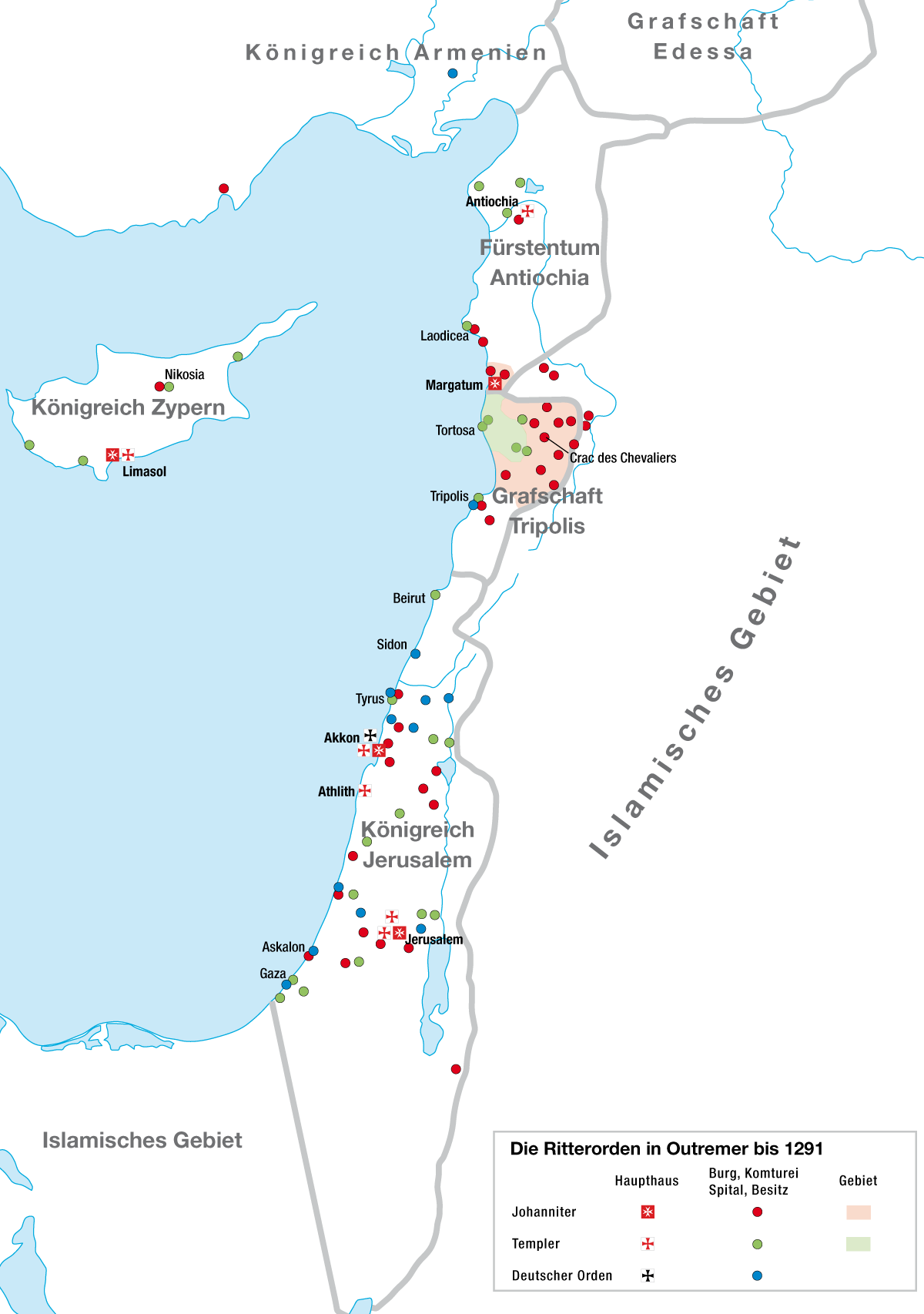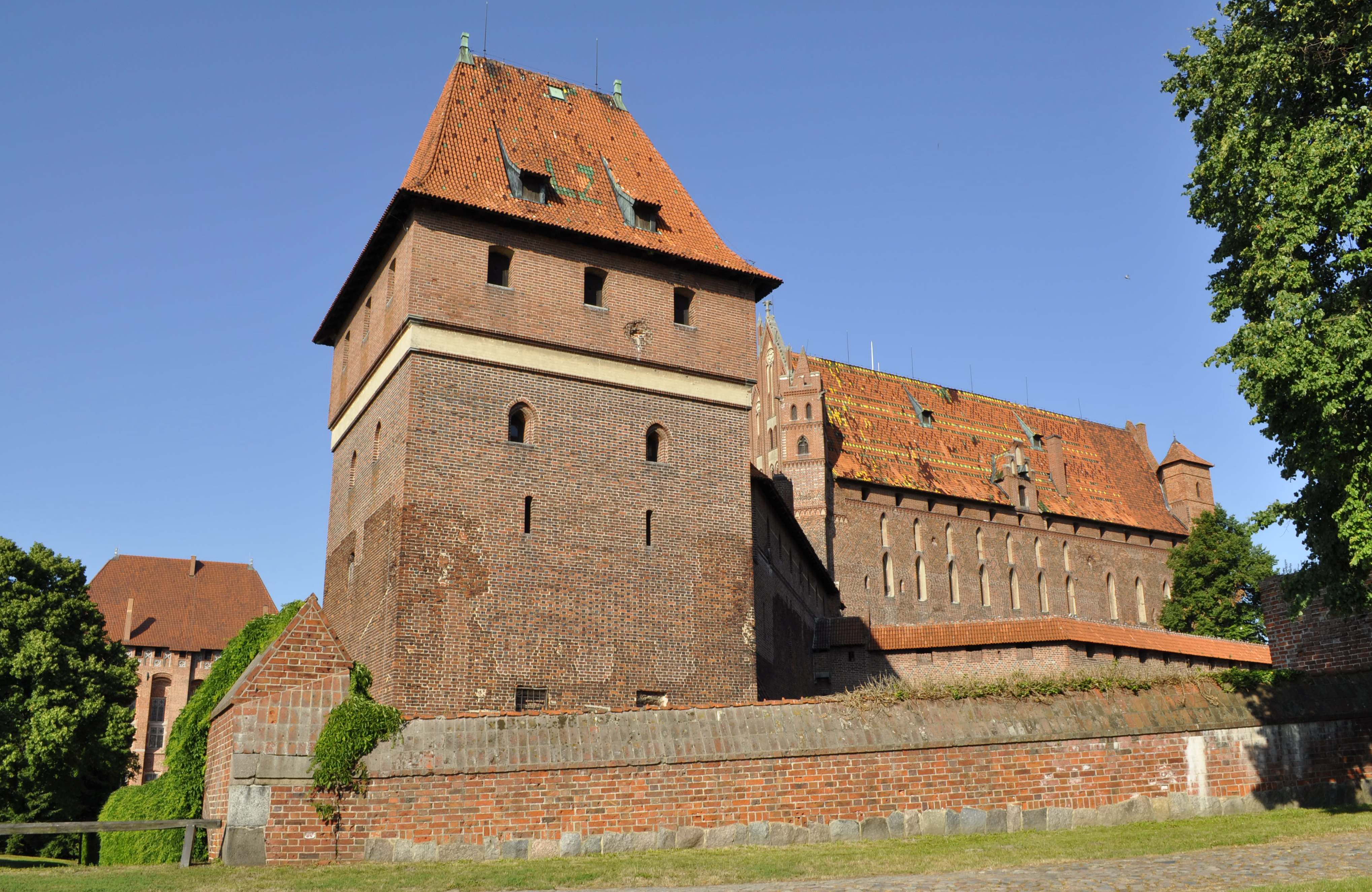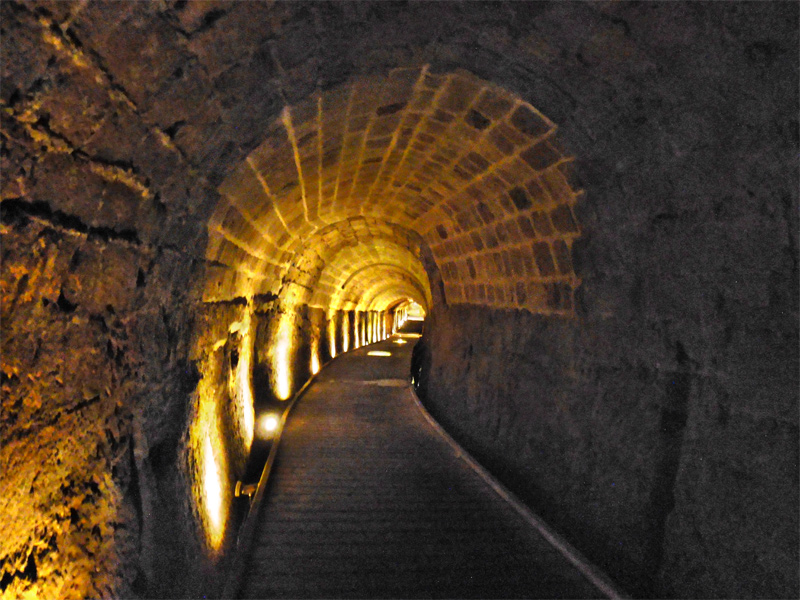|
Teutonic Order
The Teutonic Order is a religious order (Catholic), Catholic religious institution founded as a military order (religious society), military society in Acre, Israel, Acre, Kingdom of Jerusalem. The Order of Brothers of the German House of Saint Mary in Jerusalem was formed to aid Christians on their pilgrimages to the Holy Land and to establish hospitals. Its members have commonly been known as the Teutonic Knights, having historically served as a crusades, crusading military order for supporting Catholic rule in the Holy Land and the Northern Crusades during the Middle Ages, as well as supplying military protection for Catholics in Eastern Europe. Purely religious since 1810, the Teutonic Order still confers limited honorary knighthoods. The Bailiwick of Utrecht of the Teutonic Order, a Protestant order of chivalry, chivalric order, is descended from the same medieval military order and also continues to award knighthoods and perform charitable work. Name The name of the Or ... [...More Info...] [...Related Items...] OR: [Wikipedia] [Google] [Baidu] |
Military Order (religious Society)
A military order () is a Christianity, Christian religious society of Knight, knights. The original military orders were the Knights Templar, the Knights Hospitaller, the Order of the Holy Sepulchre (Catholic), Order of the Holy Sepulchre, the Order of Santiago, Order of Saint James, the Order of Calatrava, and the Teutonic Order, Teutonic Knights. They arose in the Middle Ages in association with the Crusades - in the Holy Land, the Baltic states, Baltics, and the Iberian Peninsula, Iberian peninsula; their members being initially dedicated to the protection of Christians , Christian pilgrims, and eventually to the defence of the Crusader states and the conquest of non-Christian or even non-Western Christianity , Catholic lands. They are the predecessors of Order of chivalry, chivalric orders. Most members of military orders were Laity, laymen who took religious vows, such as of Evangelical counsels, poverty, chastity, and obedience, according to Monasticism, monastic ideals. T ... [...More Info...] [...Related Items...] OR: [Wikipedia] [Google] [Baidu] |
Insignia
An insignia () is a sign or mark distinguishing a group, grade, rank, or function. It can be a symbol of personal power or that of an official group or governing body. An insignia, which is typically made of metal or fabric, is a standalone symbol of a particular or general authority. Together, insignias form a decoration with the different elements of a rank, grade, or dignity. There are many types of insignia, including civil decoration, civil and military decorations, Crown (heraldry), crowns, emblems, and coats of arms. Singular/plural "Insignia" can be used either as a plurale tantum word, i.e. unchanged for both singular and plural, or it can take the plural form "insignias", both equally valid options. The singular "insigne" is rarely used. History The use of insignias predates history, both for personal and group (especially military) use. When the insignia was meant to be seen, it was placed at top of a pole or the head of a spear. The Persians used a golden eagle as ... [...More Info...] [...Related Items...] OR: [Wikipedia] [Google] [Baidu] |
Confederation Of The Rhine
The Confederated States of the Rhine, simply known as the Confederation of the Rhine or Rhine Confederation, was a confederation of German client states established at the behest of Napoleon some months after he defeated Austrian Empire, Austria and Russian Empire, Russia at the Battle of Austerlitz. Its creation brought about the dissolution of the Holy Roman Empire shortly afterward. The Confederation of the Rhine lasted for only seven years, from 1806 to 1813, dissolving after Napoleon's defeat in the War of the Sixth Coalition.Hans A. Schmitt. "Germany Without Prussia: A Closer Look at the Confederation of the Rhine". ''German Studies Review'' 6, No. 4 (1983), pp 9–39. The founding members of the confederation were German princes of the Holy Roman Empire. They were later joined by 19 others, altogether ruling a total of over 15 million people. This granted a significant strategic advantage to the French Empire on its eastern frontier by providing a buffer between France and ... [...More Info...] [...Related Items...] OR: [Wikipedia] [Google] [Baidu] |
Bad Mergentheim
Bad Mergentheim (; Mergentheim until 1926; East Franconian German, East Franconian: ''Märchedol'') is a town in the Main-Tauber-Kreis district in the German state of Baden-Württemberg. It has a population of around 23,000. An officially recognized spa town since 1926, Bad Mergentheim is also known as the headquarters of the Teutonic Order from 1526 until 1809. Geography Subdivisions Since administrative reform in the 1970s the following villages have been part of the municipality: Althausen ''(pop. 600)'', Apfelbach ''(350)'', Dainbach ''(370)'', Edelfingen ''(1,400''; birthplace of the American biochemist Julius Adler (biochemist), Julius Adler), Hachtel ''(360)'', Herbsthausen ''(200)'', Löffelstelzen ''(1,000)'', Markelsheim ''(2,000)'', Neunkirchen ''(1,000)'', Rengershausen ''(480)'', Rot ''(260)'', Stuppach ''(680)'', Wachbach ''(1,300)'' History Mergentheim is mentioned in chronicles as early as 1058, as the residence of the family of the counts of Hohenlohe. The brothe ... [...More Info...] [...Related Items...] OR: [Wikipedia] [Google] [Baidu] |
Königsberg
Königsberg (; ; ; ; ; ; , ) is the historic Germany, German and Prussian name of the city now called Kaliningrad, Russia. The city was founded in 1255 on the site of the small Old Prussians, Old Prussian settlement ''Twangste'' by the Teutonic Knights during the Northern Crusades, Baltic Crusades. It was named in honour of King Ottokar II of Bohemia, who led a campaign against the pagan Old Prussians, a Baltic tribe. A Baltic Sea, Baltic port city, it successively became the capital of the State of the Teutonic Order, the Duchy of Prussia and the provinces of East Prussia and Province of Prussia, Prussia. Königsberg remained the coronation city of the Prussian monarchy from 1701 onwards, though the capital was Berlin. From the thirteenth to the twentieth centuries on, the inhabitants spoke predominantly German language, German, although the city also had a profound influence upon the Lithuanian and Polish cultures. It was a publishing center of Lutheranism, Lutheran literatu ... [...More Info...] [...Related Items...] OR: [Wikipedia] [Google] [Baidu] |
Malbork Castle
The Castle of the Teutonic Order in Malbork, commonly known as Malbork Castle (; ), is a Brick Gothic castle complex located in the town of Malbork, Poland, built in the 13th and significantly expanded in the 14th century. It is the largest castle in the world measured by land area and a UNESCO World Heritage Site. It was constructed by the Teutonic Order, a German Catholic religious order of crusaders, in the form of an ''Ordensburg'' fortress and named ''Marienburg'' in honour of Mary, mother of Jesus. In 1457, during the Thirteen Years' War (1454–1466), Thirteen Years' War, the castle was sold by Bohemian mercenaries to King Casimir IV Jagiellon, Casimir IV of Poland in lieu of Malbork treaty, indemnities. It then served as one of several List of Polish monarchs , Polish royal residences and the seat of Polish offices and institutions, interrupted by several years of Sweden, Swedish occupation, fulfilling this function until the Partitions of Poland , First Partition of Po ... [...More Info...] [...Related Items...] OR: [Wikipedia] [Google] [Baidu] |
Venice
Venice ( ; ; , formerly ) is a city in northeastern Italy and the capital of the Veneto Regions of Italy, region. It is built on a group of 118 islands that are separated by expanses of open water and by canals; portions of the city are linked by 438 bridges. The islands are in the shallow Venetian Lagoon, an enclosed bay lying between the mouths of the Po River, Po and the Piave River, Piave rivers (more exactly between the Brenta (river), Brenta and the Sile (river), Sile). As of 2025, 249,466 people resided in greater Venice or the Comune of Venice, of whom about 51,000 live in the historical island city of Venice (''centro storico'') and the rest on the mainland (''terraferma''). Together with the cities of Padua, Italy, Padua and Treviso, Italy, Treviso, Venice is included in the Padua-Treviso-Venice Metropolitan Area (PATREVE), which is considered a statistical metropolitan area, with a total population of 2.6 million. The name is derived from the ancient Adr ... [...More Info...] [...Related Items...] OR: [Wikipedia] [Google] [Baidu] |
Acre, Israel
Acre ( ), known in Hebrew as Akko (, ) and in Arabic as Akka (, ), is a List of cities in Israel, city in the coastal plain region of the Northern District (Israel), Northern District of Israel. The city occupies a strategic location, sitting in a natural harbour at the extremity of Haifa Bay on the coast of the Mediterranean's Levantine Sea. In the Village Statistics, 1945, 1945 census Acre's population numbered 12,360; 9,890 Muslims, 2,330 Christians, 50 Jews and 90 classified as "other".Department of Statistics, 1945, p4Government of Palestine, Department of Statistics. ''Village Statistics, April, 1945.'' Quoted in Hadawi, 1970, p40 Acre Prison, Acre's fort was converted into a jail, where members of the Jewish underground were held during their struggle against the Mandate authorities, among them Ze'ev Jabotinsky, Shlomo Ben-Yosef, and Dov Gruner. Gruner and Ben-Yosef were executed there. Other Jewish inmates were freed by members of the Irgun, who Acre Prison break, brok ... [...More Info...] [...Related Items...] OR: [Wikipedia] [Google] [Baidu] |
Religious Order
A religious order is a subgroup within a larger confessional community with a distinctive high-religiosity lifestyle and clear membership. Religious orders often trace their lineage from revered teachers, venerate their Organizational founder, founders, and have a document describing their lifestyle called a rule of life. Such orders exist in many of the world's religions. Buddhism In Buddhist societies, a religious order is one of the number of Monasticism, monastic orders of monks and nuns, many of which follow a certain school of teaching—such as Thailand's Dhammayuttika Nikaya, Dhammayuttika order, a monastic order founded by King Mongkut (Rama IV). A well-known China, Chinese Buddhist order is the ancient Shaolin Monastery, Shaolin order in Ch'an (Zen) Buddhism; and in modern times, the Order of Hsu Yun. Christianity Catholic tradition A religious order in the Catholic Church is a kind of religious institute, a society whose members (referred to as "religious (Catho ... [...More Info...] [...Related Items...] OR: [Wikipedia] [Google] [Baidu] |
Catholic Church
The Catholic Church (), also known as the Roman Catholic Church, is the List of Christian denominations by number of members, largest Christian church, with 1.27 to 1.41 billion baptized Catholics Catholic Church by country, worldwide as of 2025. It is among the world's oldest and largest international institutions and has played a prominent role in the history and development of Western civilization.Gerald O'Collins, O'Collins, p. v (preface). The church consists of 24 Catholic particular churches and liturgical rites#Churches, ''sui iuris'' (autonomous) churches, including the Latin Church and 23 Eastern Catholic Churches, which comprise almost 3,500 dioceses and Eparchy, eparchies List of Catholic dioceses (structured view), around the world, each overseen by one or more Bishops in the Catholic Church, bishops. The pope, who is the bishop of Rome, is the Papal supremacy, chief pastor of the church. The core beliefs of Catholicism are found in the Nicene Creed. The ... [...More Info...] [...Related Items...] OR: [Wikipedia] [Google] [Baidu] |
Second Czechoslovak Republic
The Second Czechoslovak Republic (Czech language, Czech and ), officially the Czecho-Slovak Republic (Czech and Slovak: ''Česko-Slovenská republika''), existed for 169 days, between 30 September 1938 and 15 March 1939. It was composed of Bohemia, Moravia, Czech Silesia, Silesia and the autonomous regions of Autonomous Land of Slovakia, Slovakia and Autonomous Subcarpathian Rus' (1938-1939), Subcarpathian Rus', the latter being renamed Carpathian Ukraine (1938-1939), Carpathian Ukraine on 30 December 1938. The Second Republic was the result of the events following the Munich Agreement, where Czechoslovakia was forced to cede the German-populated Sudetenland region to Germany on 1 October 1938. After the Munich Agreement and the German government made clear to foreign diplomats that Czechoslovakia was now a German client state, the Czechoslovak government attempted to curry favour with Germany by banning the country's Communist Party of Czechoslovakia, Commun ... [...More Info...] [...Related Items...] OR: [Wikipedia] [Google] [Baidu] |
First Czechoslovak Republic
The First Czechoslovak Republic, often colloquially referred to as the First Republic, was the first Czechoslovakia, Czechoslovak state that existed from 1918 to 1938, a union of ethnic Czechs and Slovaks. The country was commonly called Czechoslovakia a compound of ''Czech'' and ''Slovak''; which gradually became the most widely used name for its successor states. It was composed of former territories of Austria-Hungary, inheriting different systems of administration from the formerly Cisleithania, Austrian (Bohemia, Moravia, a small part of Silesia) and Kingdom of Hungary, Hungarian territories (mostly Upper Hungary and Carpathian Ruthenia). After 1933, Czechoslovakia remained the only ''de facto'' functioning democracy in Central Europe, organized as a parliamentary republic. Under pressure from Germans in Czechoslovakia, its Sudeten German minority, supported by neighbouring Nazi Germany, Czechoslovakia was forced to cede its Sudetenland region to Germany on 1 October 1938 as ... [...More Info...] [...Related Items...] OR: [Wikipedia] [Google] [Baidu] |







